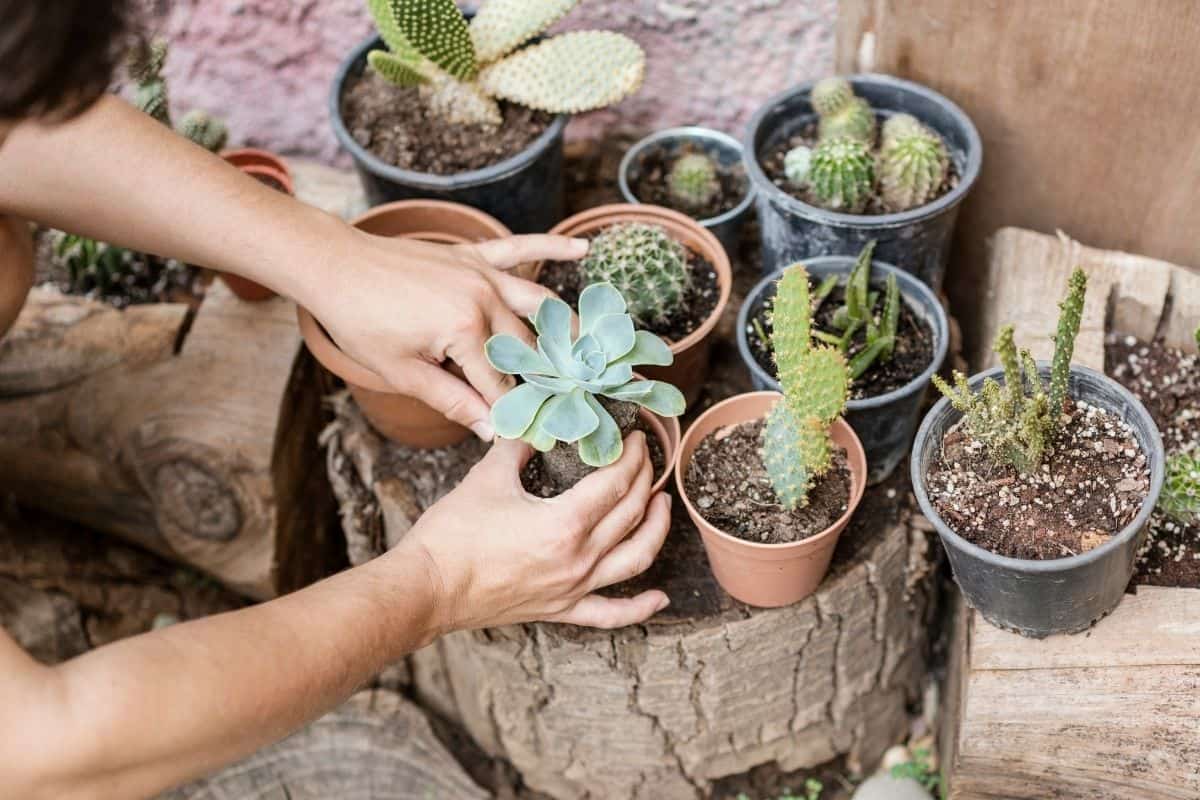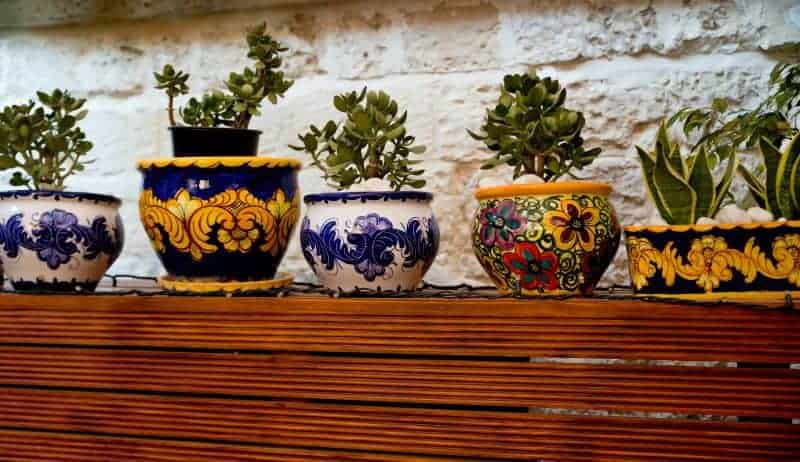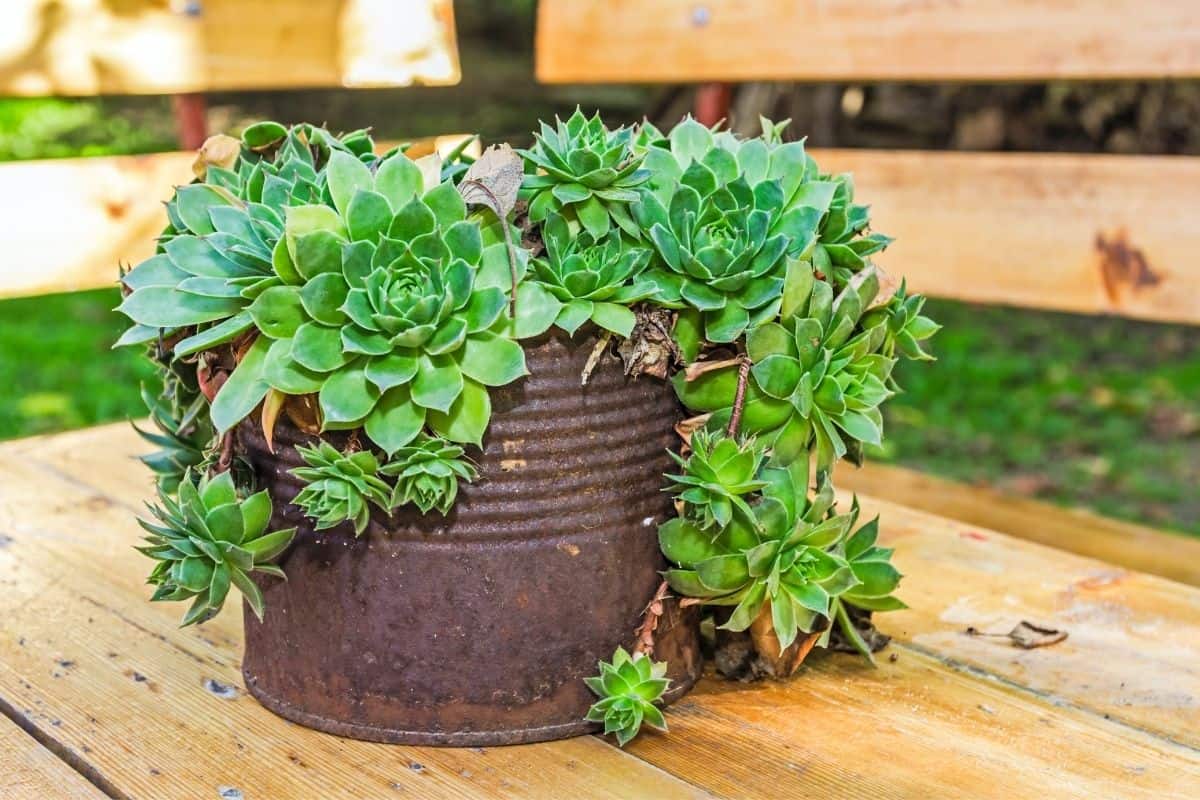
If you’ve just recently discovered your passion for succulents, you may be wondering what to plant your succulents in. The internet abounds with pictures of succulents planted in everything from recycled teacups to outdoor gardens. There are pros and cons to every type of container, but after reading this article you’ll have enough knowledge to make an informed decision on what type of container is right for your plants.
Regardless of the container, however, it’s crucial that you plant your succulents in the right type of soil. Regular potting soil is a poor choice when it comes to succulents and cacti. In fact, the succulents you bring home from the nursery may already be planted in the wrong soil. In order to give them the best chance at a long and healthy life, you want to make sure that you plant your succulents in the right soil.
Read Article: Succulent Soil vs Gritty Mix: Which is Better?
Jump to:
Planting Succulents in Containers

If you live in a climate that receives a lot of rain or the winters are long and cold, your succulents will probably do best when planted in containers. Container gardens are ideal for bringing your love of succulents indoors. Even if you live in a studio apartment, you’ll still be able to hone your green thumb.
You’ll also be able to move the plants according to their needs as well as your design preferences. Regardless of your experience level, container gardening is both easy and convenient. However, you’ll need to decide what type of container is best for you.
Terracotta

When you think of container gardens, you’ll likely picture a beautiful collection of plants growing in classic terracotta pots. Terracotta pots are incredibly popular with succulent and cacti lovers for a variety of reasons.
No products found.
Though often not as cheap as plastic pots, terracotta pots are usually quite inexpensive. They also absorb excess water from the soil, so if you tend to overwater your plants, terracotta may help keep your plants from spending too much time in wet soil. Terracotta pots also tend to insulate the soil and roots of your plants more than pots made of other materials. Although you should never expose your succulents to extreme temperatures, accidents can and do happen and terracotta can help reduce damage.
See Also: How to Repot a Christmas Cactus
Unfortunately, no type of container is perfect. One downside of terracotta is that over time, salt deposits may begin to develop on the outside of the pot. This is due to the salt content of the water you supply your succulents with. Though somewhat unsightly, salt deposits do not harm your plants. Terracotta pots are also quite fragile and can break if dropped or handled too roughly. Since terracotta is made from clay, there is generally not a wide range of colors, so if you’re looking for a splash of color, you’ll need to try a different kind of pot or just a colorful succulent.
Plastic
If you’re looking for an inexpensive, colorful, and durable container, consider planting your succulents in plastic pots. Plastic pots are available in a wide range of colors to suit any color scheme or décor. They’re also incredibly durable and flexible. Unlike a terracotta pot, if you drop a plastic pot it’s probably not going to shatter.
The downside to plastic pots is that their durability reduces the longer they’re exposed to sunlight. With time, they’ll become weak and brittle and will need to be replaced. Additionally, darker colored plastic pots may absorb heat from the sun, drying out your soil more quickly and possibly exposing your succulents’ roots to too much heat. You’ll also need to be more aware of the temperature as plastic pots will not insulate your plants as well as terracotta.
Other Materials

Although terracotta and plastic pots are the most popular types of containers for succulents and cacti, you’ll likely see succulents planted in a variety of other types of containers. From wood and metal to recycled dishes and containers, succulents can technically be planted in any type of container. Since succulents tend to have somewhat shallow root systems, many species will thrive in containers that are too shallow for other types of plants
No matter what type of container you use, it’s important to make sure it has a drainage hole. Yes, you can plant succulents in a pot without a hole, but it’s not recommended. Drainage is essential in allowing excess moisture to escape. Without proper drainage, your succulents may develop root rot.
Planting Succulents Outdoors
If you live in a climate-appropriate for growing succulents outdoors, you may be able to grow them as nature intended. Succulents grown outdoors are incredibly easy to care for, but you need to either make sure you protect them from freezing temperatures or plant only succulents that can withstand frigid weather.
If you decide to plant your succulents in the ground, rather than in containers, you’ll need to first acclimate them to outdoor conditions. Start by placing the containers in the shade or partial shade and slowly increase the amount of light over a period of a few weeks. If you don’t slowly acclimate your plants to life outdoors, you risk sunburning them.
The Importance of Good Soil

The single most important aspect you need to consider when deciding what to plant your succulents in is the quality of the soil. Remember, regular potting or gardening soil will not work for succulents. Regular potting soil tends to retain more moisture than succulents are comfortable with. Unless you live in an area where succulents grow wild, you’ll also need to be cautious about using the soil outdoors.
Your safest bet is to use a commercial soil made for use with succulents and cacti. This type of soil tends to contain larger particles such as gravel, perlite, sand, and bark. This allows for more airflow around your succulents’ roots as well as enough drainage to discourage root rot. Remember, succulents live in arid climates, so they don’t do well with excess moisture.
As long as you make sure you’re using the right type of soil and choose a container that allows for proper drainage, what you plant your succulents in will depend on your climate and your own preferences. Succulents are incredibly adaptable and do well in a range of situations so long as you also provide them with the right amount of water and sunshine.
You Might Also Like:

